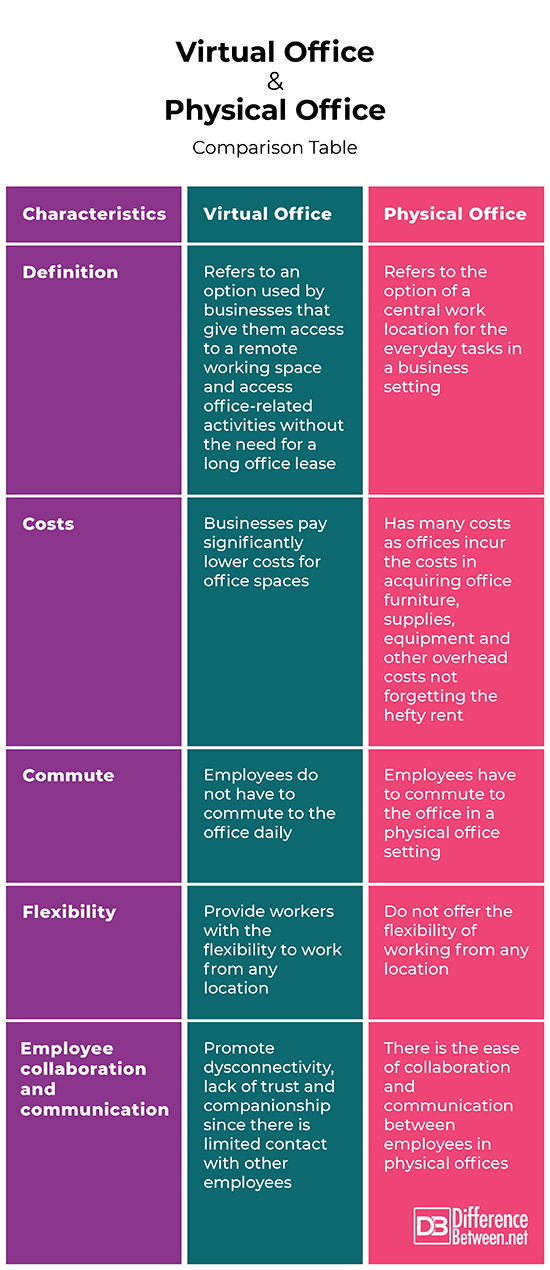Difference Between a Virtual Office and Physical Office
The trends in working spaces and organization cultures have greatly changed in the recent past. What would be regarded as abnormal has now become the new and even preferred norm to many workers and businesses. With the COVID-19 pandemic, the trend in virtual offices has gained momentum, with less use of physical offices to prevent the spread of the virus. And now, businesses are embracing virtual offices seeing that they reduce many costs, not forgetting the rise of the gig economy. Employees are also leaning more towards the trend given the freedom that comes with it. So, what are the differences between virtual offices and physical offices?

What is Virtual office?
A virtual office is an option used by businesses that give them access to a remote working space and access office-related activities without the need for a long office lease. With a virtual office, employees can access meeting rooms, phone answering services and videoconferencing. Virtual offices have gained popularity in a small business and start-ups. This trend has been accelerated by the development of messaging services and video conferencing apps.
Businesses that use the virtual office option benefit by:
- Lower overheads- The use of virtual offices means that businesses pay significantly lower costs for office spaces. These funds can hence be driven to other essential business sectors such as management and marketing.
- Fewer office conflicts- Since everything is handled via online messaging and video conferencing apps, employees get to be productive without many conflicts as would have been seen with physical offices.
- Less need for management – With virtual offices, companies do not have much management needs as virtual offices have fewer management needs.
- Increase in productivity- Virtual offices lead to increased productivity among employees. The lack of commute also saves time and enhances employee’s productivity.
- Increase in flexibility- Since employees do not have to work from a physical office, they are more flexible to work from any location so long as they get the work done.
- Easy expansion- With a virtual office, businesses can expand easily to other locations as they do not need to move to a larger office.
However, virtual offices have various disadvantages including:
- Lack of physical office space- Although many businesses are adapting to operating without a physical space, some business settings may not be sustainable without office spaces.
- Lack of structure- When operating in virtual offices, businesses ought to have a structure that should be followed to the letter. Lack of this can even lead to decreased productivity among employees.
- Lack of connectivity and community among employees- Virtual offices diminish contact among workers. As such, there may be a dysconnectivity, lack of trust and companionship that comes with physical offices. Businesses should promote a culture that enhances interpersonal relationships and connectivity.
- Distractions- Virtual offices often lead to distraction. For instance, working from home or the coffee shop often has plenty of distractions which can reduce productivity.

What is Physical office?
This is the option of a central work location for the everyday tasks in a business setting. Despite the hype around virtual offices, many businesses still prefer to stick to the option of physical offices. This largely depends on the business type, culture and funds availability.
The major reason why physical offices are largely preferred is the ability to provide a space where workers can separate their work from other life aspects. The physical offices also prove an atmosphere that instils and strengthens an organization’s goals.
Advantages of a physical office include:
- Businesses get a professional space and outlook- With physical offices, businesses have a physical spot where customers can visit them and hold meetings. Businesses with physical offices benefit through the creation of a community with the clients and the development of the brand.
- Control over office environment- Physical offices grant businesses control of the business environment. It is also easy to set up company structures and cultures.
- Ease of collaboration and communication between employees- Employees sharing a physical working space can easily collaborate and exchange ideas.
- It makes it easy to monitor the performance of employees
- It helps employees foster social skills
On the other hand, disadvantages include:
- It is expensive- Office leases can be expensive not to mention office furniture, supplies, equipment and other overhead costs.
- It limits businesses to hiring people in a given location- Although employees have a choice to move to locations close to the offices, not everyone will be flexible enough for this. As such, businesses end up losing on hiring talents globally.
- It may limit employee performance especially due to long commute hours to work
Similarities between a virtual office and a physical office
- Both aim for increased productivity in the workers
Differences between a virtual office and a physical office
Definition
A virtual office refers to an option used by businesses that give them access to a remote working space and access office-related activities without the need for a long office lease. On the other hand, a physical office refers to the option of a central work location for the everyday tasks in a business setting.
Costs
With a virtual office, businesses pay significantly lower costs for office spaces. On the other hand, a physical office has many costs as offices incur the costs in acquiring office furniture, supplies, equipment and other overhead costs not forgetting the hefty rent.
Commute
In a virtual office setting, employees do not have to commute to the office daily. On the other hand, employees have to commute to the office in a physical office setting.
Flexibility
Virtual offices provide workers with the flexibility to work from any location. On the other hand, physical offices do not offer the flexibility of working from any location.
Employee collaboration and communication
Virtual offices promote dysconnectivity, lack of trust and companionship since there is limited contact with other employees. On the other hand, there is the ease of collaboration and communication between employees in physical offices.
Virtual office and physical office: Comparison Table

Summary of virtual office vs. physical office
A virtual office refers to an option used by businesses that give them access to a remote working space and access office-related activities without the need for a long office lease. On the other hand, a physical office refers to the option of a central work location for the everyday tasks in a business setting. While both virtual offices and physical offices have amazing benefits, ensure you choose the option to work with based on the size of your team, the nature of business, availability of capital, company and team culture not forgetting lifestyle and preferences. If you opt for virtual offices, having the right structure enhances and maintains employee productivity.
- Difference Between Profit Center and Investment Center - July 2, 2022
- Difference Between Anti-Trust and Anti-Competition - June 6, 2022
- Difference Between Stocktaking and Stock Control - June 6, 2022
Search DifferenceBetween.net :
Leave a Response
References :
[0]David Holmes. Virtual Globalization: Virtual Spaces/Tourist Spaces. Routledge, 2002.https://books.google.co.ke/books?id=-pyBAgAAQBAJ&printsec=frontcover&dq=virtual+online+spaces&hl=en&sa=X&ved=2ahUKEwiEsu7I9NnuAhUHExQKHYVWBBYQ6AEwAnoECAEQAg#v=onepage&q=virtual%20online%20spaces&f=false
[1]Elke Hemminger. The Mergence of Spaces: Experiences of Reality in Digital Role-playing Games. edition sigma, 2009.https://books.google.co.ke/books?id=fN7jF7BbjAcC&pg=PA142&dq=virtual+online+spaces&hl=en&sa=X&ved=2ahUKEwiEsu7I9NnuAhUHExQKHYVWBBYQ6AEwCXoECAgQAg#v=onepage&q=virtual%20online%20spaces&f=false
[2]Kirk & Zemliansky. Handbook of Research on Virtual Workplaces and the New Nature of Business Practices. Idea Group Inc (IGI), 2008.https://books.google.co.ke/books?id=XuTiFv3b2bsC&pg=PA84&dq=virtual+online+spaces&hl=en&sa=X&ved=2ahUKEwj_wLus9dnuAhVh7eAKHX8BAxw4FBDoATAEegQIBhAC#v=onepage&q=virtual%20online%20spaces&f=false
[3]Image credit: https://cdn.pixabay.com/photo/2017/03/28/12/07/bricks-2181920__340.jpg
[4]Image credit: https://live.staticflickr.com/42/82320025_1898ee8cbb_b.jpg
